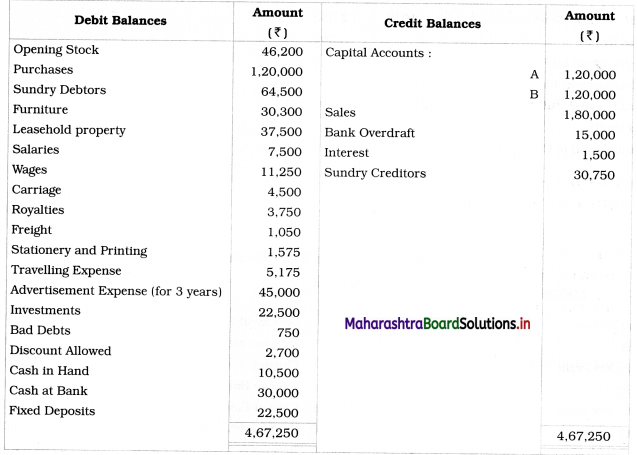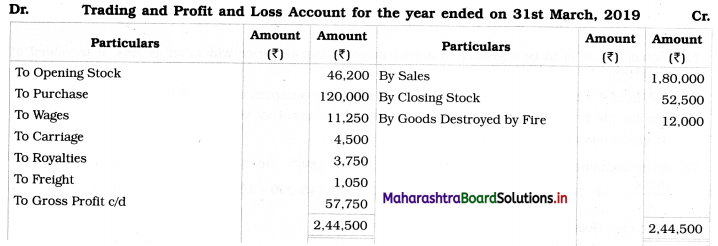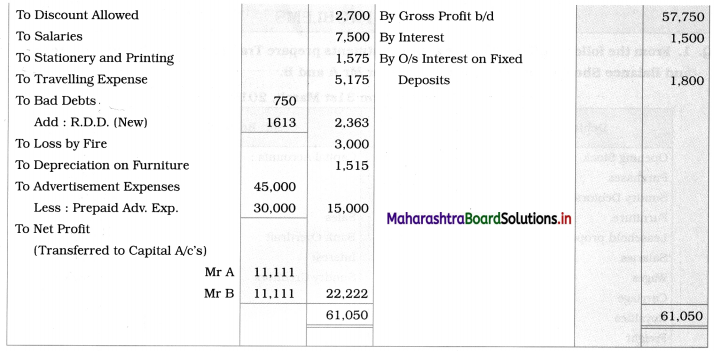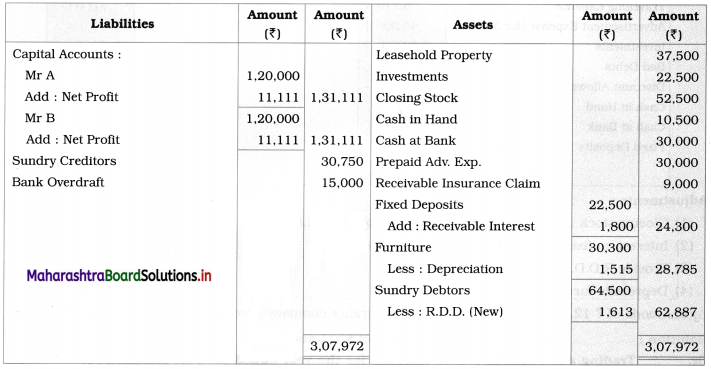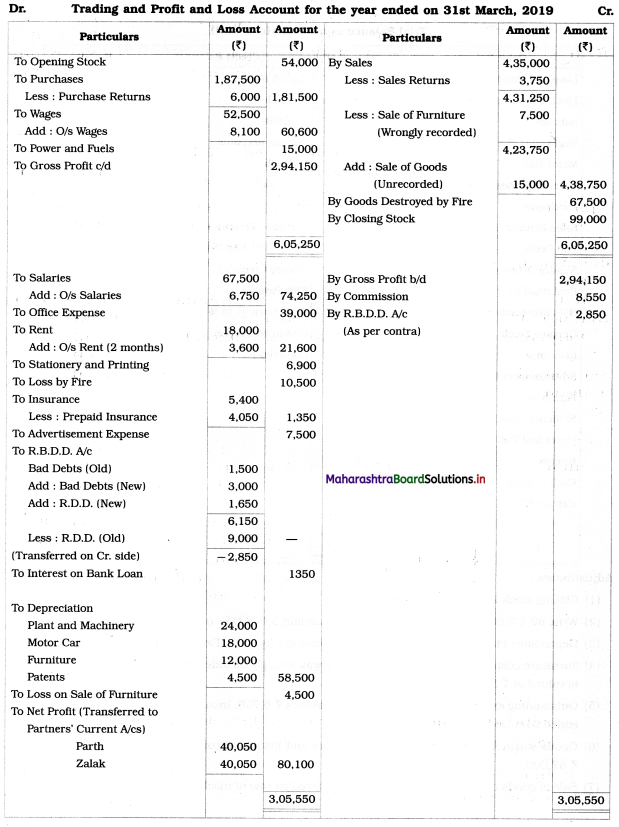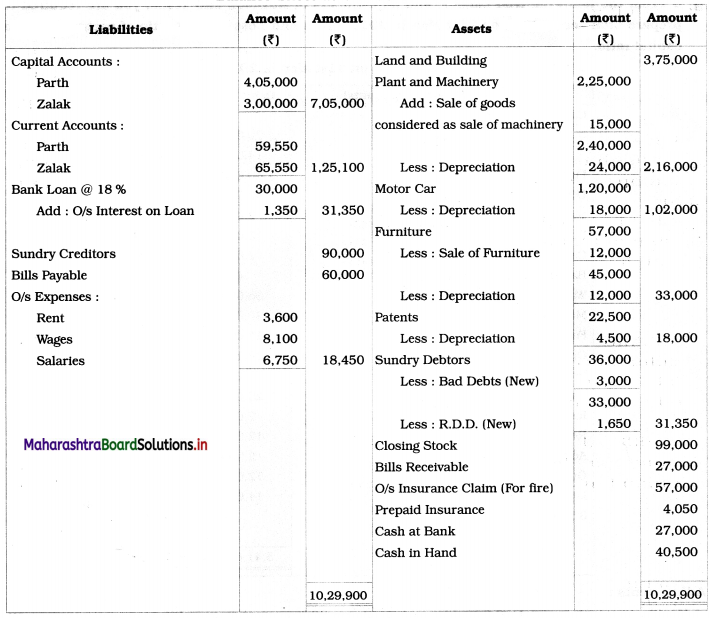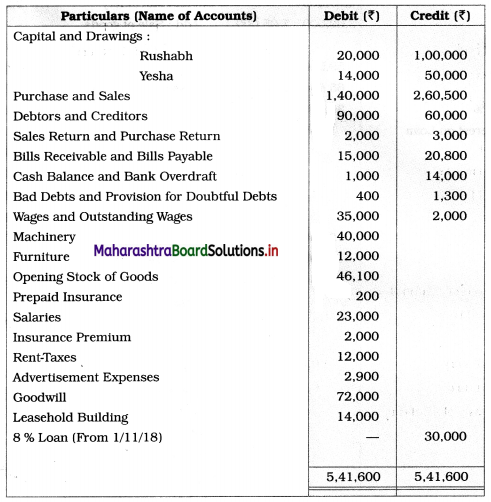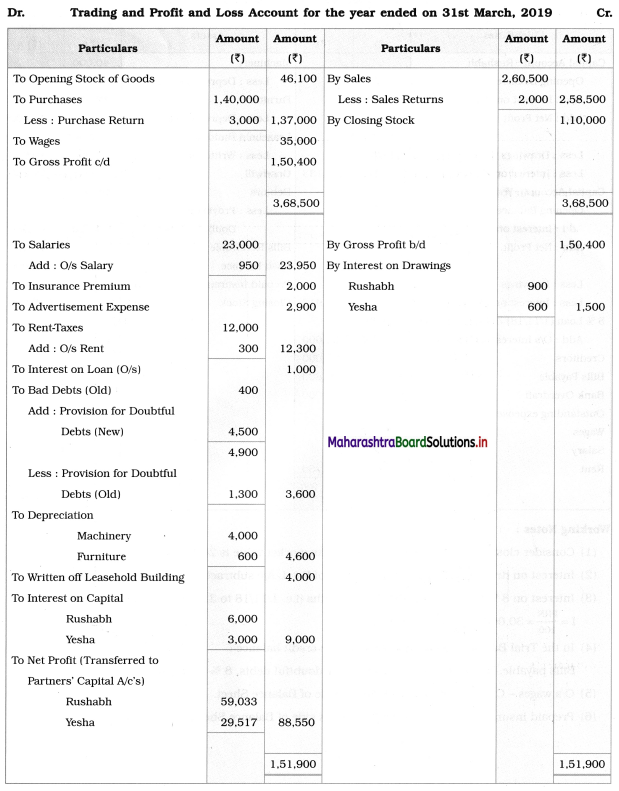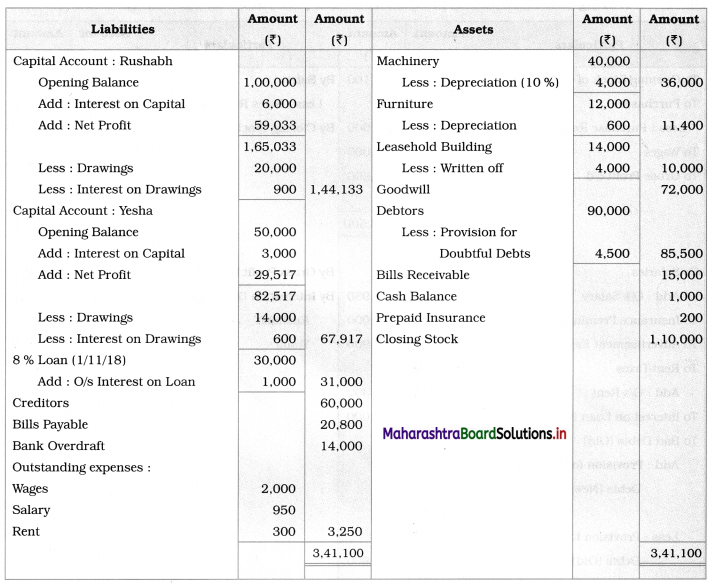Balbharti Maharashtra State Board 11th OCM Important Questions Chapter 4 Forms of Business Organisation – I Important Questions and Answers.
Maharashtra State Board 11th Commerce OCM Important Questions Chapter 4 Forms of Business Organisation – I
Select the Correct option and rewrite the sentence
Question 1.
A sole trading concern is a ………………. form of organization.
(a) private sector
(b) public sector
(c) none of these
Answer:
(a) private sector
Question 2.
A sole trading concern has ………………. liability.
(a) limited
(b) unlimited
(c) restricted
Answer:
(b) unlimited

Question 3.
Indian Partnership Act was passed in the year ………………..
(a) 1923
(b) 1956
(c) 1932
Answer:
(c) 1932
Question 4.
Minimum number of persons to start a public limited company is ……………..
(a) 2
(b) 7
(c) 10
Answer:
(b) 7
Question 5.
The minimum number of directors in a private company is ……………….
(a) 3
(b) 2
(c) 5
Answer:
(b) 2
Question 6.
Business organisation which is controlled by Hindu Succession Act is known as …………….
(a) Joint Stock Company
(b) Partnership Firm
(c) Joint Hindu Family Firm
Answer:
(c) Joint Hindu Family Firm
Question 7.
Limited managerial skill is the ……………… of Joint Hindu family business.
(a) feature
(b) limitation
(c) advantage
Answer:
(b) limitation
Question 8.
The Karta in Joint Hindu Family business has ……………… liability.
(a) unlimited
(b) limited
(c) joint
Answer:
(a) unlimited
Question 9.
The maximum number of partners for a firm carrying on banking business is ………………..
(a) Ten
(b) Twenty
(c) Seven
Answer:
(a) Ten
Question 10.
In partnership firm the liability of partners is …………….
(a) limited
(b) unlimited
(c) none of above
Answer:
(b) unlimited
Question 11.
In a partnership firm every partner is the principal as well as the ……………….
(a) agent
(b) karta
(c) partner
Answer:
(a) agent
Question 12.
In a co-operative society the principle followed is ………………
(a) one share one vote
(b) one man one vote
(c) no vote
Answer:
(b) one man one vote
Question 13.
From the point of continuity ………………… business organisation is the most suitable.
(a) company
(b) partnership
(c) sole proprietorship
Answer:
(a) company
Question 14.
A sole trading concern is ……………….. form of business organisation.
(a) latest
(b) oldest
(c) recent
Answer:
(b) oldest
Question 15.
Members of a partnership firm are individually known as ………………..
(a) partner
(b) agent
(c) co-parcener
Answer:
(a) partner
Question 16.
Joint Hindu Family business exists in …………….. only.
(a) India
(b) England
(c) all the countries
Answer:
(a) India
Question 17.
The Karta is ………………. liable for business debts.
(a) not
(b) jointly
(c) personally
Answer:
(c) personally
Question 18.
Management of a Co-operative Society is ………………….
(a) personal
(b) joint
(c) democratic
Answer:
(c) democratic
Question 19.
Rules for working of a Co-operative Society are called …………………
(a) Bye-laws
(b) Articles of Association
(c) Memorandum
Answer:
(a) Bye-laws
Question 20.
The nature …………………. of organisation is service oriented.
(a) Sole Trader
(b) Joint Stock Company
(c) Co-operative Society
Answer:
(c) Co-operative Society
Match the pairs
Question 1.
| Group A | Group B |
| (a) Registration of a Company | (1) International Market |
| (b) Sole Trading Concern | (2) Minimum no. of members is 10 |
| (c) Co-operative society | (3) Voluntary |
| (d) Joint Hindu Family Firm | (4) Partners |
| (e) Active partners | (5) Local market |
| (6) Co-parceners |
| (7) Compulsory |
| (8) Minimum no. of member is 5 |
| (9) Who lends his name |
| (10) Takes active part in business |
Answer:
| Group A | Group B |
| (a) Registration of a Company | (7) Compulsory |
| (b) Sole Trading Concern | (5) Local market |
| (c) Co-operative society | (2) Minimum no. of members is 10 |
| (d) Joint Hindu Family Firm | (6) Co-parceners |
| (e) Active partners | (10) Takes active part in business |
Question 2.
| Group A | Group B |
| (a) Indian Companies Act | (1) 1912 |
| (b) Indian Co-operative Society’s Act | (2) Joint Hindu Family Firm |
| (c) The Hindu Succession Act | (3) Sole Trading Concern |
| (d) Indian Partnership Act | (4) 1907 |
| (e) No Separate Act | (5) 1923 |
| (6) 1947 |
| (7) 2013 |
| (8) 1956 |
| (9) 1932 |
| (10) 1958 |
Answer:
| Group A | Group B |
| (a) Indian Companies Act | (7) 2013 |
| (b) Indian Co-operative Society’s Act | (1) 1912 |
| (c) The Hindu Succession Act | (8) 1956 |
| (d) Indian Partnership Act | (9) 1932 |
| (e) No Separate Act | (3) Sole Trading Concern |
Give one word/phrase/term.
Question 1.
Persons who enter into partnership business.
Answer:
Partners
Question 2.
The rules and regulations laid down by the managing committee of a co-operative society.
Answer:
Bye-laws

Question 3.
The commercial organization which ensures maximum secrecy.
Answer:
Sole trading concern
Question 4.
Kind of partnership formed under the Indian Partnership Act.
Answer:
General Partnership
Question 5.
Another name for a sleeping partner.
Answer:
Dormant partner
Question 6.
Name the kind of company in which there is non-transferability of shares.
Answer:
Private Limited Company
Question 7.
The business organization which has minimum ten members.
Answer:
Co-operative organization
Question 8.
The type of commercial organization established for providing services to its members.
Answer:
Co-operative organization
Question 9.
The rules and regulations laid down by the managing committee of a co-operative organization.
Answer:
Bye-laws
Question 10.
An artificial person created by law.
Answer:
Joint Stock Company
Question 11.
The seniormost family member of Joint Hindu Family Firm.
Answer:
Karta
Question 12.
The members of the Joint Hindu Family firm.
Answer:
Co-parceners
Question 13.
A partner in partnership firm who takes active participation in day to day work.
Answer:
Active partner
Question 14.
A business organization with a single owner.
Answer:
Sole Trading Concern
Question 15.
A partnership agreement in writing.
Answer:
Partnership Deed
Question 16.
The members of the Joint Hindu Family Firm.
Answer:
Co-parceners
Question 17.
The principle of the co-operative societies.
Answer:
Each of all, all for each
Question 18.
An organization which enjoys a separate legal existence.
Answer:
Joint Stock Company
Question 19.
A symbol of a company’s incorporate existence substitutes for its signature.
Answer:
Common seal
Question 20.
A company which need not obtain Trading Certificate.
Answer:
Private Limited Company
Question 21.
A company which can start business after obtaining Certificate of Incorporation.
Answer:
Private Limited Company.
State True or False
Question 1.
The members of the Joint Hindu Family Firm are called partners.
Answer:
False
Question 2.
The principle of one member one vote is followed in a Joint Stock Company.
Answer:
False
Question 3.
A public limited company can start business after getting the Certificate of Incorporation.
Answer:
False
Question 4.
There is no limit for membership in Joint Hindu Family Business.
Answer:
True
Question 5.
The liability of a Karta in a Joint Hindu Family Firm is limited.
Answer:
False
Question 6.
The maximum number of members in Joint Hindu Family is 20.
Answer:
False
Question 7.
Company form of organization has developed before industrial revolution.
Answer:
False
Question 8.
Shareholders can manage the business.
Answer:
False
Question 9.
The ownership and management are not separate in Joint Stock Company.
Answer:
False

Question 10.
The main purpose of a co-operative organization is to earn profit.
Answer:
False
Find the odd one
Question 1.
Sole Trading Concern, Partnership Firm, Joint Stock Company, Co-operative Society.
Answer:
Co-operative Society
Question 2.
Sleeping partner, Quasi partner, Co-parcener, Sub-partner.
Answer:
Co-parcener
Question 3.
Partnership at will, Partnership for a particular period, Limited Liability Partnership, Partnership for a particular venture.
Answer:
Limited Liability Partnership
Question 4.
Nominal partner, Active partner, Dormant partner, Minor as a partner.
Answer:
Minor as a partner
Question 5.
Grocery shop, Beauty parlour, Gift shop, Reliance Ltd.
Answer:
Reliance Ltd.
Question 6.
Hindustan Petroleum, Amul India, Mahindra & Mahindra, Renault India.
Answer:
Amul India
Question 7.
Karta, Partnership Deed, Co-parceners, Hindu Law.
Answer:
Partnership Deed
Question 8.
One Share One Vote, Service motive, Common seal, Perpetual succession.
Answer:
Service motive
Question 9.
One man show, Sole trader, Co-parceners, Single ownership.
Answer:
Co-parceners
Question 10.
Joint management, Principal agent relationship, Separate legal entity, Joint ownership.
Answer:
Separate legal entity
Question 11.
Partnership at will, Partnership for particular period, Partnership for particular venture, Limited Liability Partnership.
Answer:
Limited Liability Partnership
Question 12.
Mitakshara, Shareholders, Dayabhaga, Karta.
Answer:
Shareholder
Question 13.
One Member One Vote, Open membership, Prospectus, Service motive.
Answer:
Prospectus
Complete the sentences
Question 1.
The address of registered office of a company is mentioned in the …………………
Answer:
Memorandum of Association
Question 2.
A Sole Trading concern is best suitable for ……………………
Answer:
self employment
Question 3.
A Joint Stock company enjoys continuous and ………………… life.
Answer:
stable.
Complete the following table
Question 1.
(Consumer co-operatives, Partnership for a fixed period, Sole trading concern, Karta, Secret partner.)
| Group A | Group B |
| (i) Apana Bazar | ………………… |
| (ii) ………………… | takes utmost care of business in a Joint Hindu Family Firm |
| (iii) Partnership formed for 6 months | ………………… |
| (iv) ………………… | is not known to third parties in a partnership. |
| (v) No sharing of profits and risks is a feature of | ………………… |
Answer:
| Group A | Group B |
| (i) Apana Bazar | Consumer Co-operatives |
| (ii) Karta | takes utmost care of business in a Joint Hindu Family Firm |
| (iii) Partnership formed for 6 months | Partnership for a fixed period |
| (iv) Secret partner | is not known to third parties in a partnership. |
| (v) No sharing of profits and risks is a feature of | Sole Trading Concern |

Question 2.
(Sole trading concern, Joint Hindu Family Business, Minimum 2 directors, Partnership Firm, Co-operative Societies.)
| Group A | Group B |
| (i) Private Company | ………………… |
| (ii) ………………… | Beauty parlour |
| (iii) Principal-Agent relationship | ………………… |
| (iv) Tax Concession | ………………… |
| (v) ………………… | Partition of business |
Answer:
| Group A | Group B |
| (i) Private Company | Minimum 2 directors |
| (ii) Sole Trading Concern | Beauty parlour |
| (iii) Principal-Agent relationship | Partnership Firm |
| (iv) Tax Concession | Co-operative Societies |
| (v) Joint Hindu Family Business | Partition of business |
Question 3.
(Partnership Firm, Sole Trading Concern, Partnership firm, Co-operative Societies, Private company.)
| Group A | Group B |
| (i) ………………… | Minimum 7 members |
| (ii) ………………… | Minimum paid up capital Rs 1,00,000 |
| (iii) Owned and controlled by one person | ………………… |
| (iv) Registration Compulsory in Maharashtra | ………………… |
| (v) ………………… | Democratic Management |
Answer:
| Group A | Group B |
| (i) Public Company | Minimum 7 members |
| (ii) Private Company | Minimum paid up capital Rs 1,00,000 |
| (iii) Owned and controlled by one person | Sole Trading Concern |
| (iv) Registration Compulsory in Maharashtra | Partnership firm |
| (v) Co-operative societies | Democratic Management |
Answer in one sentences
Question 1.
What is the meaning of unlimited liability?
Answer:
Unlimited liability means if a businessman becomes insolvent and if his business assets are insufficient to pay off his business liabilities, he will have to use his private property in order to pay off his business debts.
Question 2.
Who has unlimited liability in the Joint Hindu Family Firm?
Answer:
The Karta has unlimited liability in the Joint Hindu Family Firm.
Question 3.
Who are the Board of Directors of a Company?
Answer:
Elected representatives of the shareholders are called the Board of Directors.
Question 4.
What are the members of the Joint Hindu Family called?
Answer:
The members of the Joint Hindu Family are called as Co-parceners.
Question 5.
What are Co-operating farming societies?
Answer:
Co-operative farming societies are the voluntary associations of small farmers who come together to obtain the benefits of large scale farming.
Question 6.
What are marketing co-operatives?
Answer:
Marketing co-operatives are the voluntary associations of independent producers who are willing to sell their products output at a remunerative prices.
Question 7.
What are credit co-operatives?
Answer:
Credit co-operatives are the co-operative societies which are formed by the poor people to provide financial help and to develop the habit of savings among the members.

Question 8.
What is partnership deed?
Answer:
Partnership deed is an agreement in writing which includes terms and conditions of partnership firm.
Question 9.
Who is dormant partner?
Answer:
A dormant partner is a partner in a partnership firm who contribute capital, shares profit and contributes to the losses of the firm, but does not take active participation in the working of the firm.
Correct the underlined word and rewrite the following sentences.
Question 1.
The partnership business has less capital as compared to Sole Trading concern.
Answer:
The partnership business has more capital as compared to Sole Trading concern.
Question 2.
Joint Hindu Family Business exists outside India.
Answer:
Joint Hindu Family Business exists only in India.
Question 3.
The liability of the co-parceners is unlimited in a Joint Hindu Family firm.
Answer:
The liability of the co-parceners is limited in a Joint Hindu Family firm.
Question 4.
Co-operative society is a compulsory association of individuals to provide services to its members.
Answer:
Co-operative society is a voluntary association of individuals to provide services to its members.
Question 5.
Formation of a Joint Stock company is easy.
Answer:
Formation of a Joint Stock company is complicated.
Question 6.
There is more scope for expansion in a Co-operative society.
Answer:
There is less scope for expansion in a Co-operative society.
Question 7.
In a Public company, there are minimum 2 fTwol Director’s.
Answer:
In a Public company, there are minimum 3 (Three) Director’s.
Question 8.
The registration of a Sole Trading concern is compulsory.
Answer:
The registration of a sole trading concern is not compulsory.
Explain the following terms/concepts
Question 1.
Active Partner.
Answer:
- A partner who takes active participation in day-to-day working of the firm, is called as active partner.
- He is also called as ordinary/general/ actual/ working partner.
- He acts as a manager, organizer, advisor and controller of the firm.
Question 2.
Dormant Partner
Answer:
- A partner who does not take active participation in day-to-day working of the firm, is called as dormant partner or sleeping partner.
- He contributes to the capital of the firm and also shares profit or loss of the business firm.
- He is liable for the debts of the firm.
- He cannot find the business firm or third party by his acts.
Question 3.
Unlimited Liability
Answer:
- It means that there is no distinction made between personal property and business property of a person. It further means that if business assets are not sufficient to pay off liabilities of a business than personal property of a person holding business will be attached to business property.
- Sole trader in case of sole trading concern, partners in case of partnership firm, Karta in case of Joint Hindu Family Business, has unlimited liabilities.
Question 4.
Principal – Agent Relationship
Answer:
- This term is related to partnership firm of organizations.
- In partnership firm all partners are the joint owners of the business and all takes part in the management of the business.
- Hence, every partner acts in dual role in partnership firm i.e.
(a) When within the firm they act as ‘Principal’ and
(b) When they deal with outsiders they act as an ‘Agent’.
Question 5.
Producer’s Co-operatives
Answer:
- They are voluntary associations of small producers and artisans, who come together to face the competition and increase the productions.
- Producers Co-operatives are of 2 types – (a) Industrial Service Co-operatives and (b) Manufacturing Co-operatives.
- Such co-operatives sells the output of members in the market and then profits are distributed among the members.
- They provide raw materials, implements tools, technical guidance to members on easy terms.
Question 6.
Housing Co-operatives
Answer:
- Housing Co-operatives are owned by the residents.
- Such societies purchases the land, develops it, constructs houses, etc. and allot them to members.
- They arrange loans from Government and Non-Government sources.

Question 7.
Common Seal
Answer:
- A company being an artificial person cannot sign on its own.
- So, the law requires, every company to have its seal, bearing its name on it.
- Common seal is a symbol of company’s incorporate existence. It is like a signature of the company.
- It has to be affixed on all the important documents of the company.
- It has to be witnessed by a Company Secretary and minimum 2 directors.
Study the following case/situation and express your opinion
1. Mr. Jumbo a Chartered Accountant by profession and Mrs. Timbo, an Architect by profession running a firm namely ‘Buildsheet’ in Nagpur.
Question 1.
Identify business in above example.
Answer:
Partnership firm
Question 2.
Comment on it?
Answer:
It is a voluntary association of two persons with a common objective in mind.
Question 3.
Which two professions are mentioned here?
Answer:
A Chartered Accountant and an Architect.
2. Ram and Rahim have formed a Joint Stock company to produce and sell toys with a paid up capital of Rs 2,00,000.
Question 1.
Name the type of company.
Answer:
Private Limited Company.
Question 2.
List two features of the company.
Answer:
(a) Minimum 2 members are required to form a private company.
(b) Minimum paid up capital required is Rs 1,00,000.
3. Rahul is the only owner of his restaurant. All the assets belongs to him.
Question 1.
Name the type of business organisation.
Answer:
Sole Trading Concern.
Question 2.
State two features.
Answer:
(a) Single ownership
(b) No separate entity
4. Ajit Brothers is a firm formed for the specific purpose of constructing a bridge.
Question 1.
Name this type of business.
Answer:
Partnership for a particular venture or particular partnership.
Question 2.
When does this business dissolve?
Answer:
This business will dissolve on the completion of the venture i.e. after completing the bridge.
5. Employees Union of Hindustan Mills start a retail shop to provide cloth at reasonable price to its members.
Question 1.
Identify the form of business organisation.
Answer:
The type of organisation is Co-operative society.
Question 2.
State two features of the organisation.
Answer:
(a) Voluntary membership
(b) Service motive
6. Teachers of different colleges in Mumbai form an association to buy land and construct flats for them.
Question 1.
Name the form of business organisation.
Answer:
Co-operative Society
Question 2.
Is the association of members voluntary or compulsory.
Answer:
The association is voluntary, as it is one of the features of the Co-operative Society.
7. Mr. Shyam is a shareholder of Coal India Limited. He is in need of money. He transfers his shares to another person.
Question 1.
Name the kind of company.
Answer:
Public Limited Company
Question 2.
Can he transfer his shares.
Answer:
Yes, he can transfer his shares to anyone as it is one of the main features of a Public Limited Company.
8. If the business is a sole trading concern with a capital of Rs 25,000, but the debts are amounting to Rs 50,000.
Question 1.
Is the entrepreneur liable to pay his creditors.
Answer:
Yes, he has to pay to his creditors.
Question 2.
Give reasons.
Answer:
A sole trading concern has unlimited liability therefore, he has to pay his creditors by selling off his private property.
9. Amul – the taste of India started 65 years ago in 1946 in Anand.
Question 1.
Name the type of business organisation.
Answer:
Co-operative Society
Question 2.
What was the mission for starting AMUL.
Answer:
AMUL was started with a mission to stop the exploitation of farmers by middlemen.
Distinguish between the following
Question 1.
Joint Hindu Family Firm and Sole Trading Concern.
Answer:
| Joint Hindu Family | Sole Trading Concern |
| Meaning | In Joint Hindu Family Firm, the Joint Hindu Family conducts business according to Hindu Laws. | Sole Trading Concern is owned and controlled by one person. |
| Formation | Joint Hindu Family Firm comes into existence by operation of Hindu Law. | Sole Trading Concern can be formed easily. It is started as soon as the owner decides. |
| Number of Members | Membership of the firm depends upon the birth and death in the family. There is no limit on membership. | Sole Trading Concern is owned by a single person. |
| Sharing of Profits/Losses | The profits and losses shared between Karta and Co-parceners. | The sole trader alone enjoys all the profits of business. He alone bears the losses of business. |
| Liability | Karta has unlimited liability. The liability of Co-parceners is limited. | The sole trader has unlimited liability. |
| Act | Joint Hindu Family Firm follows the Hindu Succession Act, 1956. | There is no special legislation governing the sole trading concern. |
| Stability | Comparatively more stability because if Karta dies, the next seniormost family member can take over the business. | There is no stability as life of the organization depends upon the survival of the sole trader. |
| Capital | More finance is available with the firm. Therefore, there is more capital. | Sole trader has limited funds. Therefore, the concern has limited capital. |
| Ownership | Assets and property of business is jointly owned by family members. | Assets and properties of business are owned by the sole trader. |
| Efforts and Rewards | There is no direct relation between efforts and rewards. | There is a direct relation between efforts and rewards. |
Question 2.
Partnership Firm and Joint Stock Company.
Answer:
| Partnership Firm | Joint Stock Company |
| Meaning | Partnership firm is controlled by two or more persons called as partners. | Joint Stock Company is an incorporated voluntary association created by law, having an independent legal status, owned by shareholders and managed by Directors. |
| Act | Partnership firm is governed by Indian Partnership Act, 1932. | Joint Stock Companies are governed by Indian Companies Act, 2013. |
| Membership | Minimum two partners and Maximum 50 partners. | Private company-
Minimum – 2
Maximum – 200Public company-
Minimum – 7
Maximum – No limit |
| Liability | The liability of partners is unlimited, joint and several. | The liability of shareholders is limited. Up to the unpaid amount of shares held by them. |
| Ownership & Management | Partners are owners and managers of the firm. | Joint Stock Company is owned by shareholders of the company and managed by Board of Directors. |
| Formation | The formation is simple and less costly. Only an oral or written agreement is needed between partners. | Formation of a Joint Stock Company is. difficult, costly and time-consuming. |
| Stability | A partnership firm does not enjoy a stable life. Life of the firm is affected by death, insolvency or lunacy of even one partner. | Joint Stock Company has a long and stable life. It has perpetual succession. Life of the company is not affected by death, insolvency or lunacy of any member or Director. |
| Registration | Registration of a partnership firm is optional. It is compulsory in the State of Maharashtra. | Registration of a Joint Stock Company is compulsory. |
| Legal Status | A partnership firm has no legal status that is distinct from its members. | A Joint Stock Company has a separate legal status. |
| Transfer of Shares | A partner can transfer his share only with the consent of other partners. | Shares of a public company are freely transferable. |
| Authority of Members | A partner has implied authority. He is an agent of the firm. | A shareholder has no implied authority. |
| Winding up | A partnership firm can be easily dissolved. There are not much legal formalities for winding up the firm. | A Joint Stock Company can be dissolved only by the court. A proper procedure has to be followed for dissolving the company. |
Question 3.
Sole Trading Concern and Joint Stock Company.
Answer:
| Sole Trading Concern | Joint Stock Company |
| Meaning | Sole proprietorship is owned, managed and controlled by one person. | Joint Stock Company is an incorporated association created by law, having an independent legal status, owned by shareholders and managed by board of directors. |
| Formation | Sole trading concern can be formed easily. It is started as soon as the owner decides. | Formation of a Joint Stock Company is difficult, costly and time-consuming. There are many legal formalities needed to form a joint stock company. |
| Liability | The sole trader has unlimited liability. | Shareholders have limited liability. It depends upon unpaid value of shares. |
| Numbers of Member | Sole trading concern is owned by a single person. | The minimum number of persons needed to start a private company is two and maximum is fifty. Minimum number of public company is seven and maximum is unlimited. |
| Registration | Sole trading concern need not be registered. | Joint Stock Company has to be compulsorily registered. |
| Act | There is no Act for a Sole Trading Concern. | Companies have to follow Indian Companies Act, 2013. |
| Legal Status | A Sole Trading Concern does not have a legal status. | Joint Stock Company has a legal status. |
| Secrecy | It is possible to have maximum business secrecy in a Sole Trading Concern. | Business Secrecy cannot be maintained’. Books of accounts have to be kept open for inspection to shareholders. |
| Capital | As there is only one owner, less capital is available for business. | Capital is collected from shareholders in the form of shares. Huge capital can be collected for business. |
| Stability | A Sole Trading Concern does not have a stable life. Life of the sole trader and his concern are one and the same. | The company enjoys a long stable life. |
Answer in brief
Question 1.
State any four merits of Sole Trading Concern.
Answer:
1. Easy Formation : A sole trading concern can be easily formed. Not much legal formalities are needed to start a sole trading concern. A person who is competent to enter into contract can start a sole trading concern.
2. Prompt Decision Making: A sole trader can take all decisions by himself. There is no external interference. As he can take quick decisions, prompt actions is also possible. This Organisation is suitable for business where quick decisions have to be taken. Ex. Share Trading.
3. Flexibility : The sole trader can make changes in business easily. He can expand or curtail business activity, whenever needed. He is the only person to take decisions in business. There is a lot of flexibility in sole trading concern.
4. Minimum Government Regulations : Sole trading concern need not follow any Special Act. There are not much legal formalities needed for forming and closing a sole trading concern. Only the general law of the country has to be followed. It states that a person doing sole trading business:
- must be a major (above 18 years)
- must be of sound mind
- must not be disqualified by any law to do business.

Question 2.
Explain any four demerits of Sole Trading Concern.
Answer:
1. Limited Capital : The sole trader is the only owner of business. He alone contributes capital for business. Capital is in the form of savings and borrowings from friends and relatives. In his individual capacity he cannot raise loans from banks to a large extent. The growth and expansion of business is affected because of limited capital. This is disadvantage to business.
2. Limited Managerial Ability : There is only one person to manage business. Inspite of his knowledge, the sole trader is not able to manage business efficiently. The sole trader may not be an expert in all fields like finance, advertising, management etc. Therefore, management ability is limited.
3. Unlimited Liability : The liability of the sole trader is unlimited. There is no difference between personal property and business property of sole trader. But unlimited liability prevents further expansion. He does not take risk in business. He is overcautious in taking decision which affects progress of business.
4. No Stability : A sole trading concern does not have a continuous existence. It does not have a stable life. Life of the organisation depends upon the life of the sole trader. In case the sole trader dies, becomes insolvent or insane the business has to be closed down.
Question 3.
What are the features of Joint Hindu Family Business ? (Any 4)
Answer:
1. Formation : Joint Hindu Family Business is created by operation of Hindu Law. There is no agreement between members. Each member becomes the co-parcener in the family business by birth.
2. Membership : Joint Hindu Family business has two types of partners.
(a) Karta : The seniormost male member of the family.
(b) Co-parceners (Copartners) : Other family members.
There is no limit on maximum number of members. In the state of Maharashtra, even girls born in the family become co-parceners of the firm. The number of members keep on changing depending on birth and death in the family.
3. Joint Ownership : The property of the firm is jointly owned by three generations of the family. Karta is the custodian of the joint property. All family members own the assets of business.
4. Sharing of Profits / Losses : Ratio of sharing of profits or losses of Karta and co-parceners is not given in the Hindu Act. The ratio of profit sharing keeps on changing depending on birth and death in the family.
Question 4.
Give any four demerits of Joint Hindu Family Business.
Answer:
(i) Limited Resources : Business is done by the joint family. So capital brought in by the family is limited. The capacity to raise funds is also limited as liability of co-parceners is limited. This affects growth and expansion of business.
(ii) Limited Managerial Ability : The management of business is totally taken care of by Karta. So the entire business depends upon the ability of the Karta. He does not even consult co-parceners for decision making. The Karta may not be an expert in all areas of business. Due to inadequate funds it is not possible to hire experts. Therefore, Joint Hindu Family Firm faces the disadvantage of limited managerial ability.
(iii) Unlimited Liability : The liability of Karta is unlimited. His decision making process becomes very slow. He is too cautious and unwilling to take risk in business. As there is no difference between personal property and business property of Karta he is afraid to take bold decisions. This affects the progress of business.
(iv) Limited Expansion : Even if Karta takes a lot of interest in business, the firm has the disadvantage of limited growth. Two reasons i.e., limited capital and limited managerial ability results in limited growth of business.
Question 5.
State any four merits of partnership firm.
Answer:
(i) Easy Formation : It is easy to form a partnership firm. Only an agreement is needed to start the firm. The agreement between partners may be an oral or written one. A written agreement is always preferred to avoid disputes in future. Not many legal formalities are needed for forming or closing business. Even the procedure for registration is simple.
(ii) Large Capital: Many partners come together to start a firm. Partners have joint responsibility to collect capital for the firm. As number of persons are more than sole trading concern, large capital can be collected. If business has to be expanded more capital has to be collected.
(iii) Business Secrecy : More secrecy can be maintained in business. Books of accounts need not be published. There is no legal requirement to publish annual report. Information is not leaked out to competitors, which is an advantage to the firm. If partners want they can keep secrets to themselves.
(iv) Rational Decisions : Decisions are taken collectively by partners. Two heads are always better than one.. Partners discuss can take decisions, which are always balanced. Partners have unlimited liability therefore they are careful in taking decisions.
Justify the following statements
Question 1.
There is no limit for membership in Joint Hindu Family Business.
Answer:
- Joint Hindu Family Firm is jointly owned by all family members.
- When a Hindu Joint Family does business and passes it on from one generation to another it is called a Joint Hindu Family business.
- There are two types of members in Joint Hindu Family Firm – Karta and Co-parceners.
- The membership of Joint Hindu Family Firm is unlimited.
- Membership is not limited because it depends upon the death and birth in the family. All the persons born in the family become a member of the family by birth.
- A person becomes a member even by adoption into the family.
- Thus, there is no maximum limit for membership in a Joint Hindu Family Business.
Question 2.
The membership of a co-operative society is voluntary.
Answer:
- Co-operative society is a voluntary association of persons formed for the purpose of promoting the interest of its members.
- There is open membership i.e., membership is open to all. No difference is made on language, religion, caste etc. A person becomes a member by purchasing shares of the organization.
- There is complete freedom about becoming or not becoming the member of the organization.
- A person can join on his own free will. There is no compulsion for becoming a member.
- He can leave the organization by giving due notice as and when he desires.
- The opportunity of becoming a member is given to all which means co-operative organization is a voluntary organization.
- Thus, the membership of a co-operative society is voluntary.
Question 3.
In partnership, the liability of every partner of the firm is unlimited.
Answer:
- Partnership is an association of persons competent to enter into contracts. The aim is to carry lawful business.
- All partnerships in India follow the Indian Partnership Act of 1932.
- Accordingly the liability of every partner is unlimited.
- Partners have joint and several liability. It means each partner is individually liable and jointly liable for the debts of the firm.
- There is no difference between personal property and business property of the partners. In case business assets are not sufficient to pay debts, the personal property of each and every partner can be used.
- If one partner is declared insolvent, his liability has to be borne by solvent partners.
- Thus, in partnership, the liability of every partner of the firm is unlimited.

Question 4.
The owner of the sole proprietorship is the sole decision maker of his business.
Answer:
- A sole trader does business alone.
- He invests his own capital, skill and intelligence in the management of business.
- A sole trader is the only manager of business. So he is the sole decision maker of his business.
- He is not answerable to anyone and need not consult anyone for doing business.
- There is no external interference.
- Therefore, he can take quick decisions and prompt actions and take advantage of profit – oriented situations. Thus, sole trader is the only decision maker and therefore has complete control on business.
Question 5.
Sole Trading Concern is easiest to form.
Answer:
- Sole trading concern is owned by only one person.
- A very Simple process is needed to start a sole trading concern.
- There is no complicated legal formalities to start a sole trading concern, as in the case of joint stock company.
- A licence from appropriate authority is needed.
- Only the general law of the country has to be followed for starting business.
- A person must be of sound mind, a major and must not be disqualified by any law to do business.
- Thus, sole trading concern is the easiest form of organization to be started.
